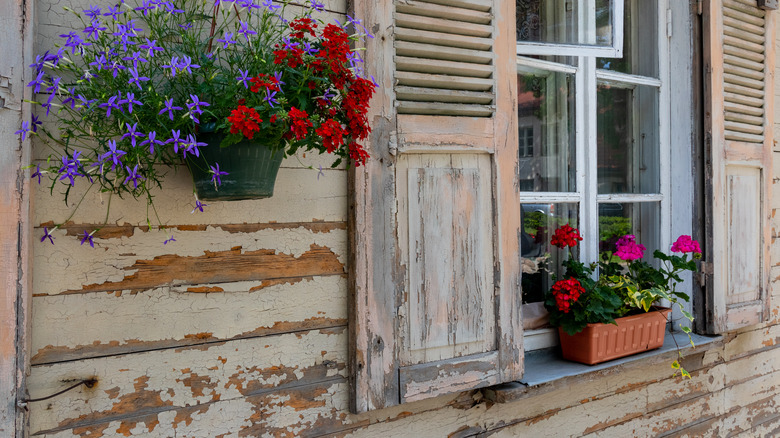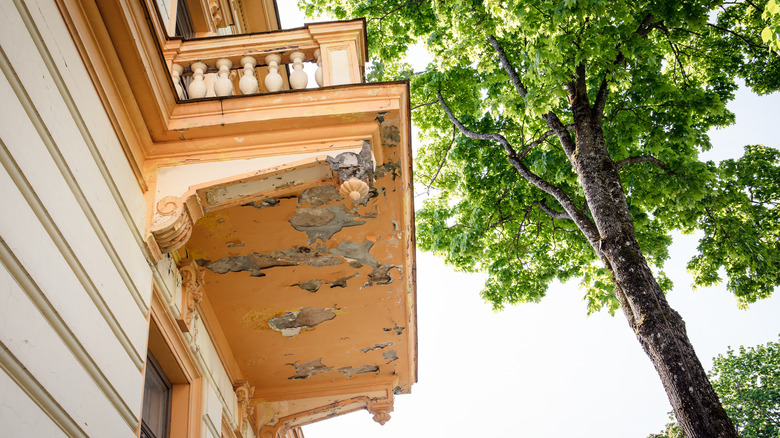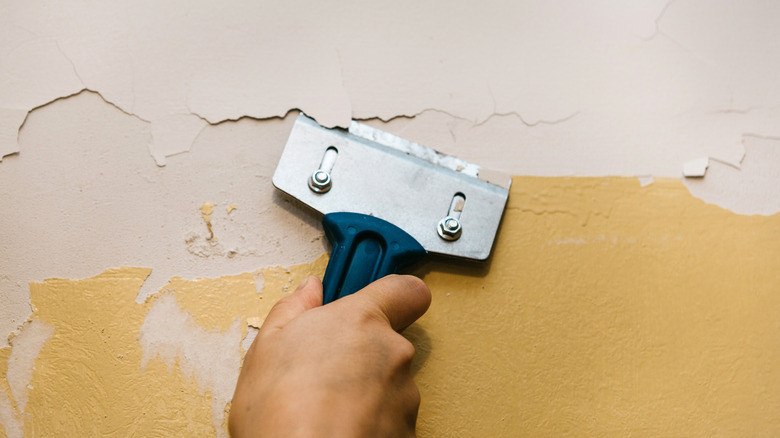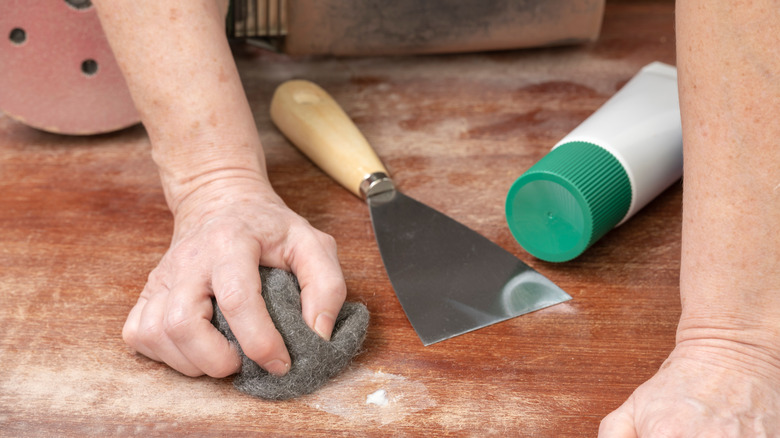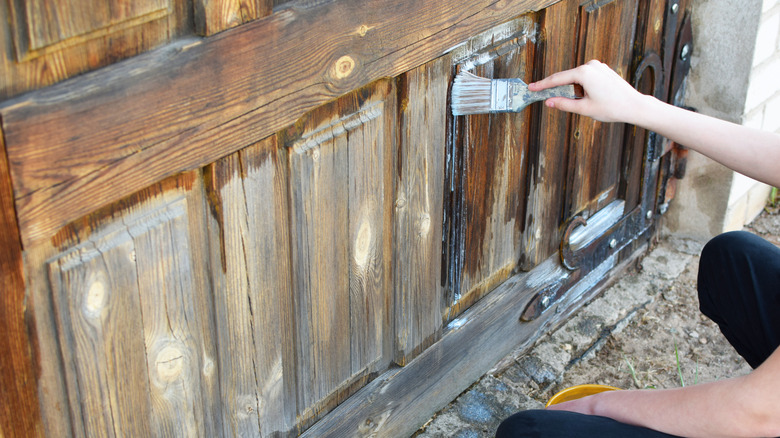4 Simple Tips To Fix The Peeling Paint On Your Home's Exterior
Peeling paint can be a sign that it's been a bit too long since your house was painted, and it needs a new coat. However, it's also possible that the paint on certain areas of your home has begun to peel prematurely. According to Monitor, the most common cause of this is water seeping into the material beneath the paint, causing swelling and cracks that just get worse over time. As the cracks are exposed to the elements, more and more water damage occurs.
As pointed out by the Seattle Times, you can think of paint as glue dyed with pigment. It sticks to a surface, and as long as the material doesn't expand or contract, it'll stay there. The sides of railway tunnels are cement, which does not absorb water, and they're sheltered from the elements. So, a light layer of spray-painted graffiti stays up there as long as it takes for someone to cover it up.
Unfortunately, according to TIME, 90% of American houses are still constructed of types of wood that are easy to build with, all of which is porous and can be easily infiltrated by water. Even though your house is covered in high quality, durable paint, eventually there will be some upkeep necessary. Continue reading for four simple tips to help fix your peeling exterior paint, hopefully without having to break the bank!
Spot the peel
Once you have an inkling that your home's exterior paint job is peeling a little, it's important to nip the problem in the bud. The first step, according to Dulux, is identifying and eliminating anything that could be causing moisture damage. It could be runoff splashing back from a gutter, condensation over time, or the first tell-tale sign of a new leak somewhere. If you don't remove the root cause of the moisture, the paint will be peeling again before you know it.
If localized water damage is not the cause of the problem, check the perimeter to find out if there are other areas of the house where peeling is happening. If the issue was localized to a few areas, you might still be able to avoid having to repaint the whole house. According to Home Depot, if peeling exterior paint isn't caused by moisture, it's often caused by improper preparation of the exterior surfaces when the house was previously painted. This is the sort of thing that could be a tiny oversight, or indicate a wider problem. If any of the paint on the outside of your house is peeling, it's key to understand the causes and extent of the peeling before you can effectively solve the issue.
Remove peeling paint
Cracked, bubbling, blistering, or otherwise peeling paint isn't just an eyesore that's potentially detracting from your property value. The layer of useless pigment creates an irritating cosmetic barrier that both hides the extent of underlying damage and will inconvenience any attempts to patch up the problem. As explained on DoItYourself.com, if you paint over paint that is peeling, you're just giving yourself two layers of paint to deal with later. Use a scraper to gently lift and remove the areas that are already peeling.
According to Home Repair Geek, in all likelihood the paint damage extends beyond the area that is visibly peeling. Therefore, count on including the area about 6 to 12 inches out from the obvious damage. Use this as a way to estimate how much work it will take to fix the paint, so you don't get caught trying to repair a tiny area in 20 minutes and bite off more than you can chew. Taking your time and being thorough will minimize any minor mistakes and oversights, and maximize the longevity of your home's exterior paint.
Clean it out, fill the gap, and sand it down
Once you have eliminated the source of any moisture and removed the peeling paint, you can assess the underlying situation. Sometimes there will be a large crack or another kind of hole. Other times there is little of note. In either case, the surface needs to be prepared to be repainted.
According to Behr, the damaged area needs to have all dust and debris removed with sandpaper and a wet rag. The sandpaper prepares the surface for better adhesion from the patching compound or putty you'll use to fill in the cracks and gaps, which would otherwise cause the new paint surface to look uneven. Depending on the size of the gap, there are different kinds of caulking and filler materials to consider. Whatever product you decide suits your particular needs, make sure it is formulated for exterior use. Most fillers shrink as they harden, so add more layers if needed. You want to overfill the gap slightly, and smooth it down a few inches out from the edge.
The final step is to sand the surface and clean away the dust one more time. Make sure the surface is completely dry and clear of dirt before painting, in order to avoid repeating the same mistakes!
Primer for patch-ups
An alternative approach that will provide temporary relief, but is not a long-term solution, is to cover peeling paint with a peel-stopping primer, according to Home Made Lovely. This is a particularly thick primer coat that can seep into the flaky surfaces at the edge of peeling paints and glue them down, as well as priming the exposed wood for maximum paint adhesion.
As Image Works Painting, Inc. explains, these new primers aren't miracle cures and you will still need to prepare the surface of your house by removing old paint, cleaning, and sanding the edges as usual. However, using primers can help avoid having to strip huge swaths of your home's exterior to fully repair peeling chips.
DIY Geeks stresses that painting or priming over peeling paint is a poor plan, particularly in the long term. So keep in mind that the edges will eventually pop up again, and you'll have even more peeling paint to contend with. However, if you can't fully strip and repaint your house simply because you can't afford how much it costs to paint the exterior of your home, this could be the stopgap solution you need.
